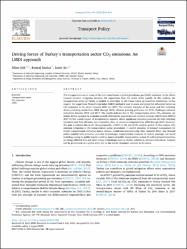Driving forces of Turkey's transportation sector CO2 emissions: An LMDI approach
Künye
Işık, M., Sarıca, K. & Ari, İ. (2020). Driving forces of Turkey's transportation sector CO2 emissions: An LMDI approach. Transport Policy, 97, 210-219. doi:10.1016/j.tranpol.2020.07.006Özet
The transportation sector is one of the main contributors to global greenhouse gas (GHG) emissions. As the efforts towards emission mitigation increase, the expectation from the sector arises equally. In this analysis, the transportation sector of Turkey is studied to shed light on the future based on historical realizations. In this respect, the Logarithmic Mean Divisia Index (LMDI) method is used to assess and reveal the influential factors on CO2 emissions in the sector between 2000 and 2017. The emission intensity of the sector and fuel switching shows promising trends from 2000 through 2010, whereas growing preference for SUVs challenges emission reductions between 2010 and 2017. The results indicate that i) The transportation sector CO2 emissions are mainly driven upwards by economic growth, followed by population and emission intensity effects from 2000 to 2017 ii) The overall impact of transportation intensity shows significant reduction potential iii) Fuel switching incentives and fleet efficiency have a positive effect on emission mitigation from 2000 through 2010. However, this gain is reduced due to the rising popularity of SUVs in the rest of the analysis period. In this respect, CO2 emission mitigation in the transportation sector necessitates 1) careful planning of demand management for freight transportation including master designs production/manufacturing sites, material flows, and demand points coupled with economic activities 2) passenger transportation measures to reduce passenger car travel including zoning for public transit corridors, improved public transportation system 3) well-structured incentives on energy-efficient cars and clean energy technologies such as electric vehicles to convince individuals. Analysis can be generalized on a global scale due to the similar dynamics inherent in the sector.
Kaynak
Transport PolicyCilt
97Aşağıdaki lisans dosyası bu öğe ile ilişkilidir:
İlgili Öğeler
Başlık, yazar, küratör ve konuya göre gösterilen ilgili öğeler.
-
In situ fluorescence study of swelling, sorption and desorption processes in and out of PAAm gels
Evingür, Gülşen Akın; Karslı, Kadir; Pekcan, Mehmet Önder (Wiley-V C H Verlag GMBH, 2008-05)Small molecule sorption and desorption in and out of polyacrylamide (PAAm) gels were studied at various temperatures. Pyranine (P(y)) dissolved in water used as a probe. Fluorescence emission intensity, I(p) from P(y) was ... -
Challenges in the CO2 emissions of the Turkish power sector: Evidence from a two-level decomposition approach
Işık, Mine; Ari, İzzet; Sarıca, Kemal (Elsevier Ltd, 2021-06)Decarbonization of the energy system is urgent to avert the disruptions in the climate. Considering its share, the low carbon transition of the power sector is pivotal. Growing electricity demand poses unique challenges ... -
Bubble dynamics and shock waves
Delale, Can Fuat (Springer Berlin Heidelberg, 2013-01-01)This volume of the Shock Wave Science and Technology Reference Library is concerned with the interplay between bubble dynamics and shock waves. It is divided into four parts containing twelve chapters written by eminent ...


















